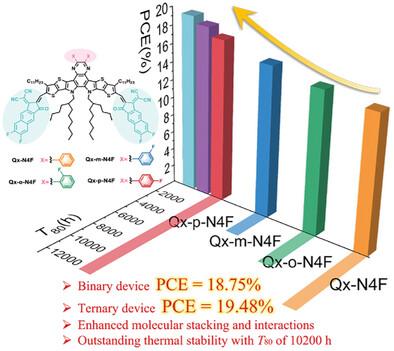当前位置:
X-MOL 学术
›
Adv. Energy Mater.
›
论文详情
Our official English website, www.x-mol.net, welcomes your
feedback! (Note: you will need to create a separate account there.)
Efficient and Stable Organic Solar Cells Achieved by Synergistic Optimization of Extended End‐Capped Groups and Fluorinated Quinoxaline Central Cores in Nonfullerene Acceptors
Advanced Energy Materials ( IF 24.4 ) Pub Date : 2024-11-14 , DOI: 10.1002/aenm.202403806 Chi Zhang, Yanan Shi, Jing Tao, Jianqi Zhang, Hao Zhang, Dingding Qiu, Caixuan Wang, Chenyang Tian, Zhixiang Wei, Kun Lu
Advanced Energy Materials ( IF 24.4 ) Pub Date : 2024-11-14 , DOI: 10.1002/aenm.202403806 Chi Zhang, Yanan Shi, Jing Tao, Jianqi Zhang, Hao Zhang, Dingding Qiu, Caixuan Wang, Chenyang Tian, Zhixiang Wei, Kun Lu

|
Molecular stacking behavior exerts a significant influence on the blend film morphology of organic solar cells (OSCs), further affecting device performance and stability. Modulation of the molecular structure, such as central unit and end‐group, can profoundly impact this process. Herein, four quinoxaline (Qx)‐fused‐core‐based non‐fullerene acceptors (NFAs), Qx‐N4F and Qx‐o/m/p ‐N4F are synthesized combining π‐extended end‐groups and optimized central units. The isomeric fluorinated central units lead to changes in the local dipole moments and electrostatic potential distribution, which influences the molecular stacking pattern and photoelectronic properties of NFAs. Consequently, binary and ternary devices based on PM6:Qx‐p ‐N4F achieve superior power conversion efficiencies (PCE) of up to 18.75% and 19.48%, respectively. Grazing‐incidence wide‐angle X‐ray scattering (GIWAXS) characterization reveals Qx‐p ‐N4F's stronger crystallinity, aggregation, and donor–acceptor interactions, which can separately enhance short‐circuit current density (J SC ) and fill factor (FF) through higher phase purity and tighter molecular stacking based on maintaining more donor–acceptor interfaces. Furthermore, PM6:Qx‐p ‐N4F‐based devices demonstrate exceptional thermal stability, retaining 93.2% of the initial PCE value after 3000 h of heating due to the best morphological stability with the most stable stacking structure. These results underscore the significance of synergistic optimization of NFAs through conjugation expansion and halogenation substitution for obtaining efficient and stable OSCs.
中文翻译:

通过协同优化非富勒烯受体中的扩展封端基团和氟化喹喔啉中心核心实现高效稳定的有机太阳能电池
分子堆叠行为对有机太阳能电池 (OSC) 的混合膜形态产生重大影响,进一步影响器件的性能和稳定性。分子结构的调节,如中心单元和末端基团,可以对这一过程产生深远的影响。在此,合成了四种基于喹喔啉 (Qx) 融合核的非富勒烯受体 (NFA),Qx-N4F 和 Qx-o/m/p-N4F,结合了π延伸的末端基团和优化的中心单元。异构体氟化中心单元导致局部偶极矩和静电势分布发生变化,从而影响 NFA 的分子堆叠模式和光电特性。因此,基于 PM6:Qx‐p‐N4F 的二元和三元器件分别实现了高达 18.75% 和 19.48% 的卓越功率转换效率 (PCE)。掠入射广角 X 射线散射 (GIWAXS) 表征揭示了 Qx-p-N4F 更强的结晶度、聚集和供体-受体相互作用,这可以通过更高的相纯度和更紧密的分子堆叠分别提高短路电流密度 (JSC) 和填充因子 (FF),同时保持更多的供体-受体界面。此外,基于 PM6:Qx‐p‐N4F 的器件表现出卓越的热稳定性,由于具有最佳的形态稳定性和最稳定的堆叠结构,在加热 3000 小时后仍保留 93.2% 的初始 PCE 值。这些结果强调了通过共轭扩增和卤化取代协同优化 NFA 对于获得高效和稳定的 OSC 的重要性。
更新日期:2024-11-14
中文翻译:

通过协同优化非富勒烯受体中的扩展封端基团和氟化喹喔啉中心核心实现高效稳定的有机太阳能电池
分子堆叠行为对有机太阳能电池 (OSC) 的混合膜形态产生重大影响,进一步影响器件的性能和稳定性。分子结构的调节,如中心单元和末端基团,可以对这一过程产生深远的影响。在此,合成了四种基于喹喔啉 (Qx) 融合核的非富勒烯受体 (NFA),Qx-N4F 和 Qx-o/m/p-N4F,结合了π延伸的末端基团和优化的中心单元。异构体氟化中心单元导致局部偶极矩和静电势分布发生变化,从而影响 NFA 的分子堆叠模式和光电特性。因此,基于 PM6:Qx‐p‐N4F 的二元和三元器件分别实现了高达 18.75% 和 19.48% 的卓越功率转换效率 (PCE)。掠入射广角 X 射线散射 (GIWAXS) 表征揭示了 Qx-p-N4F 更强的结晶度、聚集和供体-受体相互作用,这可以通过更高的相纯度和更紧密的分子堆叠分别提高短路电流密度 (JSC) 和填充因子 (FF),同时保持更多的供体-受体界面。此外,基于 PM6:Qx‐p‐N4F 的器件表现出卓越的热稳定性,由于具有最佳的形态稳定性和最稳定的堆叠结构,在加热 3000 小时后仍保留 93.2% 的初始 PCE 值。这些结果强调了通过共轭扩增和卤化取代协同优化 NFA 对于获得高效和稳定的 OSC 的重要性。


















































 京公网安备 11010802027423号
京公网安备 11010802027423号